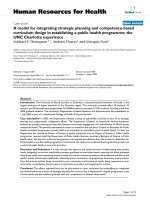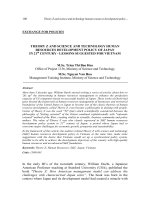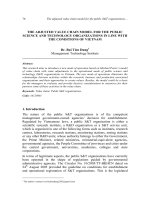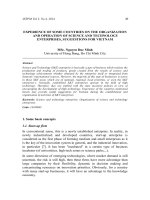The adjusted value chain model for the public science and technology organizations in line with the conditions of Vietnam
Bạn đang xem bản rút gọn của tài liệu. Xem và tải ngay bản đầy đủ của tài liệu tại đây (231.9 KB, 10 trang )
76
The adjusted value chain model for the public S&T organizations…
THE ADJUSTED VALUE CHAIN MODEL FOR THE PUBLIC
SCIENCE AND TECHNOLOGY ORGANIZATIONS IN LINE WITH
THE CONDITIONS OF VIETNAM
Dr. Bui Tien Dung1
Management Technology Institute
Abstract:
This research aims to introduce a new mode of operation based on Michael Porter’s model
of value chain with some adjustments to the operational mode of public science and
technology (S&T) organizations in Vietnam. The new mode of operations illustrates the
relationships between activities within the research, business and production associated
organizations and their approaches to create values. Besides, the model could be a basis
for the managers to evaluate and provide decisive considerations to outsource for their
partners some of these activities in the value chain.
Keywords: Value chain; Public S&T organizations.
Code: 16120801
1. Introduction
The nature of the public S&T organizations is of the competent
management government-owned agencies’ decision for establishment.
Regulated by Vietnamese laws, a public S&T organization is either a
scientific research institute, a R&D organization or a S&T service unit,
which is organized in one of the following forms such as institutes, research
centres, laboratories, research stations, monitoring stations, testing stations
or any other R&D units; whose authority belongs to either the Government,
the Prime Minister, related ministries, ministerial-equivalent agencies,
governmental agencies, the People Committee of provinces and cities under
the central government, universities, academies, colleges and state
corporations.
In terms of legitimate aspects, the public S&T organisations have currently
been operated in the shape of regulations guided by governmental
administrative agencies. The Circular No. 10/2005/TT-BKHCN dated on
24th August 2005 provided the guideline on conditions for establishment
and operational registration of S&T organizations. This is the legislated
1
The author’s contact is at
JSTPM Vol 5, No 4, 2016
77
document on registration and operational activities of S&T organizations,
whose ownerships are irrespective of any economic sector types (State,
collective or private economic sector). Some of the newest basic points of
the Circular include: Firstly, in addition to the rights to conduct scientific
research activities and S&T services, the public S&T organizations are
allowed to be involved in production and business in the related field of
activities; Secondly, the operational registration issued by the competent
administrative state agencies is the only needed requirement for the private
S&T organizations, without any decisions granted for operation; Thirdly,
for the first time, the foreign-owned S&T organizations are allowed for
operational registration; Fourthly, the S&T organizations are allowed to be
linked and jointed venture to other foreign scientific researchers and
organizations for operational registering and conducting S&T activities.
There are also guidelines from other legitimate documentations, such as:
the Joint Circular No. 11/2007/BCA-BKHCN, dated on 27th July 2007, on
guideline for the public S&T organizations to invite foreign experts and
scientists into Vietnam and to send Vietnamese officials to abroad on duties
that are related to S&T activities; the Circular No. 121/2014/BTC-BKHCN,
dated on 25th August 2014 on guideline on estimation, management, use
and fund reimbursement of the regular functional-based tasks of the public
S&T organizations; the Joint Circular No. 12/2006/TTLT-BKHCN-BTCBNV; the Joint Circular No. 36/2011/TTLT-BKHCN-BTC-BNV;…
However, in addition to conducting scientific research and S&T services,
the S&T organizations are entitled to the production and trading in their
field of activities. So, the question is that what the operational mode are
suitable for these public S&T organizations in Vietnam. Creatively based
on the model of the value chain of Michael Porter, the author of this article
has built up new model of value chains with nine types of specified
activities of the public S&T organizations in Vietnam. On the basis of
putting R&D activities in the centre, the new value chain model will
provide a clearer insight on activity operational modes that adapted to the
current conditions of Vietnam.
2. Michael Porter’s model of value chain
Originally, Michael Porter’s value chain (Figure 1) is a model
demonstrating a sequence of activities that involved in the product’s value
creation and the profits gain from these activities. This chain of activities
could occur in sequence or in parallel. The model fits for the research,
business and production associated units. The model of value chain consists
of three components:
78
The adjusted value chain model for the public S&T organizations…
First, the group of main activities: includes the activities that occur in
sequence. This group of activities is directly involved in the product’s value
creation. The main activities in this group include: Logistics of the inputs:
receiving, transporting, storing of input materials; Manufacturing: product
creation; Logistics of the outputs: conducted products, storages in
warehouse; Marketing and sales: product introduction, product sales;
Services: maintenances, repairing and costumer supports;
Second, the group of supporting activities: includes the activities that occur
in parallel to the main activities in order to support the product creation.
These are the activities that indirect contribute to product’s value creation.
The activities in this group include: Purchasing: purchasing of machineries,
equipments and input materials; Technological development: innovating of
products and production processes; Human resource management:
recruitment, training, developing and remunerating of human resources;
Corporate infrastructure: management, finance, accounting, legal issues,…
Third, Profits are the difference between revenues and costs. The
production and business unit will gain profits if the total revenues from
sales are greater than the total costs. In the model of value chain, the
revenues are the values of goods sold and the values are created through the
activities shown on the model of value chain. The costs are the amount
spent to carry out these activities.
Source: Porter, 1985, pp. 37
Figure 1: Michael Porter’s model of value chain with nine types of activities.
3. The approach of value chain in the case of the public S&T
organizations
The following ways of approaches could be used for the public S&T
organizations to recognize their advantages in Michael Porter’s value chain:
JSTPM Vol 5, No 4, 2016
79
First, for the use of a simple analysis of value chain, including the
identification of different main and supporting activities, that significantly
contributes to reduce the cost or create the uniqueness.
Second, for the identification of competitive advantages which include the
analysis of new possibilities on linkages of these activities in the value
chain. As long as the S&T organizations are able to manage these linkages,
they could:
-
Identify different processes and select the optimal solutions. For
example, a S&T organization could choose to meet the just demand of
individual/organization partners or choose to control the quality of the
entire conducted products;
-
Reduce costs; for example, the operating costs could be reduced by
improving operational coordination in logistics activities;
-
Reduce time for processing orders as to provide faster services for the
costumers;
-
Improve the quality of products/services and lower the rates of defect
products.
The S&T organization, which aims to introduce strategic products, would
need to redesign the linkages between the activities so that both inside and
outside collaborations are enhanced to well address S&T tasks.
Third, for being found within the linkages between the S&T organizations
and the suppliers and traders’ own value chains, the Porter’s idea was not
about the cost savings over the planned expenditure of the suppliers or
traders. These two partners could both gain benefits, because it is not a
game with a total sum of zero. For example, a confectioner decided to
choose liquid chocolate as input ingredients instead of condensed chocolate
provided by the trader. This decision helped to save costs of smelting
process for the confectioner, as well as to reduce the unnecessary stages of
pouring chocolate into molds and condensing them into chocolate bars for
the chocolate trader (Michael Porter, 1985).
Fourth, the last way of approach to the value chain is related to the
integration of the value chain of the S&T organization to the value chain of
the users which are either another S&T organization or a local household,
depending on the related products or services. In the case that the costumer
is a S&T organization, it could be as a direct integration into the value
chain as in the case of a supplier and a trader. In the case that the costumer
is a local consumer, the point is to understand the costumer’s value chain
and to meet his demand by a suitable kind of products and services. For
The adjusted value chain model for the public S&T organizations…
80
example, for one manufacturer in the field of climbing gears and
mountainous traveling, the key point is to be knowledgeable on the types of
terrains and weather conditions that his products would be used for. The
more suitable that the products are met the needed demands and actual
practice, perhaps including the extremely tough and dangerous situations,
the greater the commercial success would be achieved (Michael Porter,
1985).
All of these above approaches own their own advantages; and suitable
adjustments in majority of these activities in the original Porter’s value
chain are needed to the public S&T organizations.
4. The development of the types of activity in the value chain that is
suitable to the public S&T organizations in Vietnam
As shown in Figure 2, the nine types of activities in the original Porter’s
model of value chain was adjusted to suitable to the operational mode of the
public S&T organizations.
Infrastructure for research
Managing S&T human and developing experts team
Supporting
activities
Administrative management
Fund allocations for projects
S&T
ideas
Scientific
research and
technological
development
Activities of
pilot production
Publication and
scientific
assessment
Services network
development
Feedback information
Main activities
Figure 2: The model of value chain for the public S&T organizations
4.1. Adjusted group of supporting activities
a) The supporting activities on developing R&D infrastructure
The development of specified infrastructure for R&D is extremely
important and represents the level and position ranking of the S&T
organizations. It is the reason why the type of supporting activities on
developing R&D infrastructure is more suitable for this type of
organizations. Equipments, machineries and specified tools that are related
JSTPM Vol 5, No 4, 2016
81
to technical processes are necessary in research and development. The most
obvious feature of this type of activity is capital intensive for developing
and purchasing all of these various kinds of equipments as well as
maintenances of lab equipments and other related activities.
b) The supporting activities on S&T human resource management and
expert team development
The development of qualified S&T human resource and ranked expert team
in the related field of activities could be considered as a crucial factor.
Many unique, new and specified techniques are developed during practical
research, which could not be borrowed, lend or mimicked in the short term
period. This would be one of the most important advantages for public S&T
organizations in Vietnam. An unique feature of S&T organizations is that
the quantity and quality of research outputs are counted on the excellent
individual researchers’ performance.
On the other hand, managers should be aware that it would be an extremely
tough and huge challenge to manage S&T in the way that encourages
researchers’ creativity. An unsuitable management mode and improper
managers might result in a properly complete collapse of a strong S&T
organization with a number of top professionals and modern and adequate
facilities.
c) The supporting activity on administrative governance
In order to achieve the targets planned in the government-oriented research
environment, financial management, legal consulting activities related to
intellectual property, contracts and other non-technical operational supports
are under the management of the organizational agencies. The S&T
organization needs to maintain an administrative division that is refined and
flexible. Besides, the public S&T organizations should avoid recruiting any
so-called “superfluous” at work or “childish” in perception (Decree No.
115/2005).
d) The supporting activity on budget allocation for projects
The budget allocation activity is not limited within the organization itself;
in other words, the public S&T organizations might receive many other
various sources of funding (such as being sponsored by government,
individuals or organizations,…). In Vietnam, the S&T contracts for S&T
tasks are a bit delayed and lasted in a quite short-term duration (often up to
three years); therefore, if project managers look forward to continuously
developing their projects, they might need to be very proactive, diverse and
agile, instead of “waiting” of funding. Otherwise, the projects might
probably face difficulties in a shortage of time, lack of funding, breach of
82
The adjusted value chain model for the public S&T organizations…
contracts and inability to retain good professionals. In order to survive and
maintain the continuality of operation, the S&T organizations need to
possess a quite large amount of variable capitals (which are not easy to be
estimated) in order to allocate and maintain the operation in the short and
medium term. In all cases, the public S&T organizations in Vietnam are not
strong enough to cover all of their needs.
4.2. Adjusted group of main activities
a) The main activities start with the idea creation and development
Ideas for scientific research and technological development come not only
from the researchers, but also arise mainly from the practical production
and business. It is known from the experts that the outputs of S&T activities
do not count merely on the number of refereed articles, international
conference papers or the number of graduated masters or PhDs. However,
S&T organization’s function such as services for production and business is
over demanded by the society. This is not simply done. Moreover, new
research topics are often collided in ideas with partners, who want to check
the suitability of the research on their actual production.
b) The main activities of scientific research and technological development
Typically, the research would be carried out by itself as planned.
Meanwhile, the role of the researcher is merely to promote the research
activities and to ensure that the research could be carried out with modern
equipments. However, there has been a disparity in the current management
mode. The results of research in public S&T organizations are publicly
disseminated; and intellectual property belongs to the management
representatives of the state agencies. Meanwhile, the results of S&T
activities funded by individuals and non-state organizations or private
investment are not necessarily published; and the issue of intellectual
property ownership could be negotiated.
c) The contracts on research and trial production
When R&D activities end up with promising results, manufacturers and
traders would like to involve in with a certain amount of investment in the
forms of contracts. Under the scope of this paper, the discussion on the
forms of these contracts will not be discussed because this depends much
on the S&T organizations and their selected partners.
d) The main activity on research publications and evaluations, which
replaces the function of marketing and sales in the Porter’s model, due to
the fact that these terms are unfamiliar in the public S&T organizations in
Vietnam
JSTPM Vol 5, No 4, 2016
83
To be R&D units, the public S&T organizations always highly
acknowledge S&T activities and their outputs. Thus, the function of
marketing and sales is not a common term in the public S&T organizations
in Vietnam. The term of “research publications and evaluations” is very
popular and familiar to them; even though there would be a number of
issues to be discussed on these terms.
e) The scientific achievements and the value added to the production
In the Figure 2, the outputs of the value chain were not the profits as shown
in the original Porter’s model, which were replaced by new research outputs
and value added to the production. The change in terms would be better
suited for the S&T organizations since the nature of these organizations
eventually aims to create value added to the manufacturing and service
sectors. However, the profits that the S&T organizations possibly obtain
could come from a part of new products’ value chain or from technological
transferring activities.
g) The main activity on information feedbacks
Additionally, Figure 2 has the information feedback connections, which
show the linkages between various activities within the S&T organizations.
These are also a form of quality control. By this way, it is easy to observe
any improvements in performance of the entire process by learning from
mistakes and practicing for the changes.
5. Some remarks on the development of brand building for the S&T
organizations and measures to increase the products’ value added
In order to increase the values of the products, the public S&T
organizations could choose either of these following options:
Option 1, by increasing the products’ values: the benefits of the products/
services and the reputation/position of the S&T organizations are required
to be increased/improved.
Option 2, by decreasing the total investment costs: these costs are required
to be declined through a reduction in prices, simple procedures of
purchasing, creating favorable conditions for the purchase and use of
goods,...
Both of these two options require the coordination in all activities of the
S&T organizations. However, it should be noted that, although costumers
are put at the centre and measures to pursuit the high level of satisfaction of
the costumers are considered as a focus of the S&T organizations, it does
not mean they need to increase their level of satisfaction by any means.
84
The adjusted value chain model for the public S&T organizations…
This increase must be tied to business objectives, associated with the
organizations’ available resources and within some certain competitive
conditions. The S&T organizations should follow the philosophy that said:
to strive for ensuring a high level of satisfaction for the partners on the basis
of ensuring the satisfaction level of other various subjects that are related to
the organization (Prajogo et al. 2008).
Basically, the value chain include nine operational activities, which are
corresponding to the strategy to create greater product value, including five
main activities and four supporting activities. Figure 2 illustrates the
generalization of the (adjusted) value chain for the public S&T. From these
above diagrams, it can be seen that there are a number of issues should be
taken into consideration for the S&T organizations in order to create greater
values for customers as the basis for building a strong brand:
First, the four main activities should be well carried out because these
activities play major roles in creating product values. The main activities
include: the idea formed from the organizations; scientific research and
technological development; the contracts for the development of
applications; scientific publications and evaluations, provision of service
networks. It is a chain of work, from the introduction of the inputs to the
organizations, then processing them to the production of finished products,
sales and other operational activities to serve the users.
Second, the supporting activities would also need to be invested by the S&T
organizations. Even though these activities are neither directly nor play
major roles in creating product values, they are still very meaningful to
assist all of above main activities; without these supporting activities, it is
impossible to carry out the main activities. For example, infrastructure of
the S&T organization has significant influences to all main activities;
human resource management also involves in all types of activities.
Third, the task given to the S&T organizations is to regularly check the
costs and the results while implementing each of the activities that create
values, and to continuously improve these activities so that they could be
better operated than what their competitors could do. There are the only
ways to achieve competitive advantages.
Fourth, in order to achieve the highest values, it does require not only the
efforts to achieve good results in individual operational activities
separately, but also good coordination of all various activities within the
organizations. In other words, there must avoid the circumstances that
JSTPM Vol 5, No 4, 2016
85
single departments in the organization merely aim to maximize their
concerned benefits without taking into considerations of the common
interests of the organization and their partners.
Conclusion
The classic model of Michael Porter’s value chain with nine activities is
sufficient for the public S&T organizations in Vietnam to experience what
the production and business activities for the purpose of profits look like.
Therefore, the development of activities in the value chain model (which
can be seen as a strange concept) can be useful for the current S&T
organizations. Because it can be considered as a tool in the strategic
planning and management to keep the activities of the organizations more
focused, active and flexible. In this value chain, the supporting activities
associated with information feedbacks could be helpful to remark
comprehensively to the inner activities of the S&T organizations. The
outputs of this value chain are remarkable because it could be measured by
the outputs (which are the S&T achievements) and the values added of the
new products on the market.
The model represented above is only in the form of principal models. To
put this model in the reality, further studies on implementation are needed
with trial applications on a number of S&T organizations, especially in
Hanoi and Ho Chi Minh City (if these S&T organizations agreed to
cooperate)./.
REFERENCES
In Vietnamese:
1.
Bui Tien Dung. (2016) More financial measures for S&T development, Journal of
Finance, Ministry of Finance, Vol.1, No. 628.
2.
Bui Tien Dung. (2014) Innovating financial mechanisms for public S&T
organization: issues raised. Journal of Finance, No.1/2014.
In English:
3.
Michael Porter. (1985) Competitive advantage: Creating and Sustaining Superior
Performace. New York, The Free Press.
4.
Prajogo D.I., McDermott, P., God M. (2008) Impact of value chain activity and
innovation. International Journal of Operations & Production Management, 28 (7),
pp. 615-635.









